Idaho leaders want feds to answer their water question
Letter from Little and Bedke questions executive branch’s efforts to gather groundwater information
Idaho leaders are pushing against a federal effort to collect information on groundwater nationwide.
The topic of groundwater management is complicated, at times fraught with conflict, and increasingly urgent as Idaho has one of the fastest rates of groundwater depletion in the country.
Gov. Brad Little and Lt. Gov. Scott Bedke sent a letter on Sept. 23 to President Joe Biden and Vice President Kamala Harris to express concern over efforts to gather information and potentially increase oversight of groundwater in the states. They asked them to pause action on a report until their questions were answered.
“The recent request for information from the President’s Council of Advisors on Science and Technology (PCAST) is alarming to Idahoans, particularly in the agricultural community,” the letter said. “The overly broad request for information suggests the council has already predetermined the actions needed by the federal government with respect to our groundwater.”
The letter cites an April 25 news release from PCAST, a council of experts outside government who make science and technology policy recommendations to the White House.
The request for information to compile a report states, “In the western states especially, groundwater resources are being depleted at an alarming rate, mostly from agricultural withdrawal.”
The council has created a working group to “consider the challenges and opportunities to improve our understanding and stewardship of this critical resource.”
The council asked for input that addressed questions such as, “How can we efficiently scale groundwater recharge while mitigating risks?” and “What strategies and incentives can help limit groundwater over-use?”
On Oct. 1, six members of the U.S. Congress, including Idaho Reps. Mike Simpson and Russ Fulcher, wrote to the director of the council asking to pause the report and address a series of questions and to emphasize their position that, “It is not the role of the Federal government to manage or regulate groundwater.”
Their letter included questions about what statutory authority the executive branch had to create the working group, what the cost was to the taxpayers, and what the next steps were based on the report.
There were also questions about why the council didn’t use the formal request for information process, and didn’t publish the request in the Federal Register.
Little’s office told the Tribune that this question of notification prompted his concern over the request.
“The Governor’s Office has been tracking the White House’s inquiry into states’ groundwater since the PCAST request was made earlier this year,” Press Secretary Joan Varsek said in an email. “Governor Little became particularly concerned because the Biden-Harris administration did not go through a formal notification process to the states.”
Little and Bedke’s letter did not mention the notification process; it asked questions about the states’ involvement in creating it and in developing the report or recommendations.
Groundwater in Idaho
The Gem State has about 70 major aquifers, according to the Idaho Department of Environmental Quality. The largest is the Eastern Snake River Plain Aquifer, which is the sole source of drinking water for around 200,000 people in south east and south central Idaho.
More than four-fifths of monitoring wells in Idaho have shown a large decrease in water levels since the 1980s, according to data compiled by the New York Times, and 79% of monitoring wells hit record lows in the past decade.
The Idaho Department of Water Resources attributes declines to both groundwater pumping and more efficient uses of surface water — for instance, lined canals don’t leak water, which means less water is lost but it isn’t seeping back into the ground to recharge the aquifer, Deputy Director Brian Patton said.
The Eastern Snake River Plain Aquifer has been the center of concern for years, but it came to a head in May when the Department of Water Resources issued a groundwater curtailment order that would have affected around 500,000 acres of mostly farmland throughout eastern Idaho.
Older surface water rights take priority over junior groundwater users. There was a projected shortage for a senior water right holder, which meant the junior groundwater users had to put in place a mitigation plan.
The curtailment order was paused, and as of this month, water users and the department are nearing agreement on a long-term groundwater mitigation plan, East Idaho News reported Tuesday.
Idaho’s management of water is in some ways more sophisticated than other states, according to Jonathan Oppenheimer, government relations director at the Idaho Conservation League.
“Idaho, I think, is years ahead compared to other states,” Oppenheimer said.
The state leads in its combined surface water and groundwater management, he said, and in many of its recharge efforts — but that doesn’t mean there aren’t still problems.
“Idaho does a better job of tracking and understanding some of the dynamics between groundwater and surface water,” Oppenheimer said, “but we are not immune to the reality that we’re seeing continued declines of our groundwater at pretty alarming levels.”
The state ranks high among other counties in per capita usage, Oppenheimer said, and a lot of the more recent declines align with the rise in the growth of alfalfa, especially in the Magic Valley — which relies on the Eastern Snake Plain Aquifer.
The crop is a high-protein food source for cattle, which is important especially for dairy cattle that are producing huge quantities of milk per day. Dairy is a major export from Idaho and a significant economic driver.
Alfalfa is also a water-intensive crop.
The water consumption of the hay was highlighted in a report released this spring that found growing alfalfa and other hays accounted for 46% of all direct water consumption from the Colorado River — which is a major water source for several Western states and is facing historically low levels. In the Upper Basin, cattle-feed crops accounted for more than three times what was consumed for municipal, commercial, or industrial uses combined, the report said.
While the example is for surface water and Idaho doesn’t rely on the Colorado River, the issues there may serve as somewhat of a bellwether for problems to come if Idaho doesn’t manage its supply.
“We’re frankly already seeing some of those similar patterns relative to groundwater depletion and the types of crops that are planted,” Oppenheimer said.
The Idaho Department of Water Resources doesn’t yet have definitive evidence linking alfalfa to declining aquifer levels in eastern Idaho, Patton said.
Finding a balance to protect agriculture in the region and ensure long-term sustainability of the resources will be key, Oppenheimer said, and will take participation from everyone involved.
“Obviously, agriculture is a critical component of Idaho’s economy, and one of the reasons we’ve seen growth in that industry is because of the availability of water,” he said. “As Idaho continues to grow, and as we see growth in the communities and increasing demands for water, we need to make sure that we’re protecting both agricultural interests as well as other community interests.”
The Gem State did not contribute to the request for information from the president’s council, the governor’s office said, and won’t until its questions were answered.
Oppenheimer said the conservation league could support a nationwide approach to protecting groundwater, because “it’s easier to conserve the water that you have and to keep water clean than it is to try to create water in the future or to clean it up.”
However, given that water management has always been up to the states, that may be a hard sell.
“Water administration is a state responsibility,” Patton said. “Any hint of federal involvement makes states nervous.”
Guido covers Idaho politics for the Lewiston Tribune, Moscow-Pullman Daily News and Idaho Press of Nampa. She may be contacted at lguido@idahopress.com and can be found on Twitter @EyeOnBoiseGuido.










